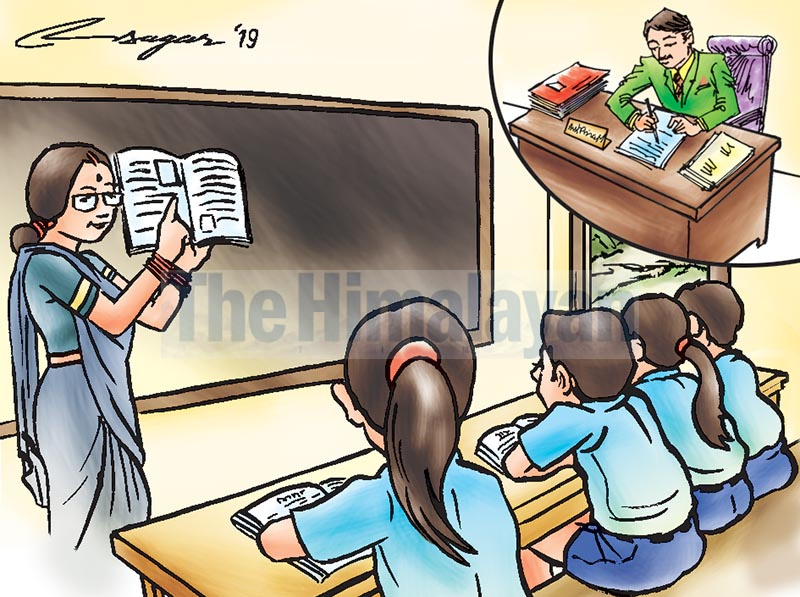School education system: Have role for assistant principal
The beauty of distributed leadership is that it acknowledges the failure of the supremacy of a single person in the organisational leadership and suggests that leadership in the educational establishment prevail at all levels
School principals are rightly attributed for the success of their school. Also taken as ‘headmaster’, the principal has always been at the top of the school organogram, the day-to-day plans and decisions involving the teachers and staff. The principal’s tasks range from dealing with the local education or school inspector to holding meetings with parents whose child has had a discipline issue. In short, the principal is the backbone of the school, responsible for the overall functioning of the school.
Articles 93 and 94 of the Education Regulation, 2059 (8th Amendment, 2071) define the procedure for the appointment of the principal in community schools and also list his or her responsibilities. The five broad management functions of the principal are: decision making, strategic, communications and cooperation, administration and leadership functions. On analysing the functions, the principal seems to be heavily burdened and does not have ample time to prepare strategies, plans and policies for the overall functioning of the school.
Some of the functions can be included in more than one category as they are not mutually exclusive. Planning classroom activities with the teachers, monitoring their activities, having meeting with the teachers at least once a month, creating yearly development plans for the school and teacher training can be included under the strategic functions. Similarly, collaboration between teachers and parents, record keeping of school activities and reporting them to the concerned stakeholders are communications and cooperation functions a school principal has to perform.
Since school principals are taken as the administrative chief or head of the school, functions related to administration like maintaining the educational environment, quality and discipline, and school cleanliness, and carrying out the daily routine and non-routine tasks are performed by the school principal.
Further, recommending for rewarding teachers or staff, providing job description to the staff and teachers, and evaluating teacher performance are the human resource management functions she/he has to perform. Apart from these, several other roles of handling guests, being aware of the recent developments in the education system and leadership styles, and making a number of decisions related to school management make the role of the school principal challenging.
The school principal is engaged comparatively more in the strategic and communications and administration functions within the school.
Principals can thus be said to be involved in many activities within the school and outside. In such a case, the principal is burdened especially when the school size is relatively big with many teachers and students. The role of the principal in such a case starts to become ambiguous when she/he has to be involved in a variety of tasks at the same time.
An important function of the principal is to go through the lesson plans prepared by the respective subject teachers and also see if the teachers have checked or marked the notebooks or exercise copies of the students, a function still not mentioned in the Education Regulation of Nepal. In such a situation, there is a need for structural change in the schools where there is a provision for hiring an assistant principal or coordinator.
The principals are shouldered with a load of administrative as well as overall school management functions, providing them little time and space for coordinating with the teachers. One wonders if the principal has even enough time to oversee the lesson plans and weekly plans prepared by the teachers or to monitor and instruct the teachers in order to achieve their daily lesson objectives.
The Secondary Education Examination (SEE) is a way of assessing how successful the education system has been. According to the Ministry of Education, Science and Technology, about 24.34% (majority) and 21.82 % of the students had a score grade C in the SEE in 2074 and 2075 B.S., respectively.
Though there can be multiple reasons for such results, it can also be directly traced to the policies, instructions and directions and role played by the school principal.
Our principals need support, and their burden needs to be divided and shared. The beauty of distributed leadership is that it acknowledges the failure of the supremacy of a single person in the organisational leadership and suggests that leadership in the educational establishment prevail at all levels.
It thus considers not only the principals as leaders but also the teachers and administrative in-charge. At present, only a few institutional schools have appointed assistant principals and coordinators to help with the responsibilities of the principal, and the principal as such has more time to focus on the curricula and the academia rather than being engaged in the administrative and reporting works.
Thus, in the present context of Nepal, where the school principal has to shoulder different categorical functions and responsibilities, it is time to introduce a structural shift and thus provide the space for assistant principals in the regulations itself. This would help improve the overall achievement of the school and the education system in the country.






